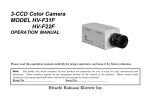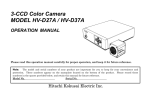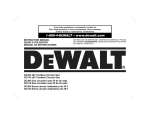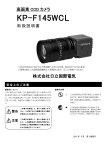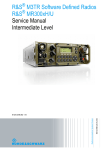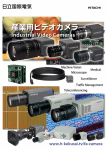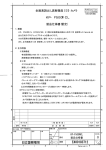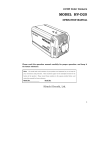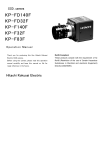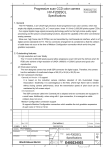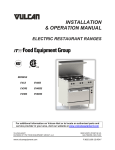Download Hitachi Webcam kp-f500pcl/scl User's Manual
Transcript
High pixel CCD camera KP-F500PCL/SCL KP-FR500PCL/SCL Operation Manual Thank you for purchase this fine Hitachi Kokusai Electric CCD camera. Before using the camera, please read this operation manual carefully and keep this manual on file for ready reference in the future. Hitachi Kokusai Electric Inc. RoHS Compliant These products comply with the requirement of the RoHS (Restriction of the use of Certain Hazardous Substances in Electrical and electronic Equipment) Directive 2002/95/EC. IMPORTANT SAFETY INSTRUCTIONS 1. Read Instructions All the safety and operating instructions should be read before the product is operated. 2. Retain Instructions The safety and operating instructions should be retained for future reference. 3. Heed Warnings All warnings on the product and the operating instructions should be adhered to. 4. Follow Instructions All operating and use instructions should be followed. 5. Cleaning Unplug this product from the wall outlet before cleaning. Do not use liquid cleaners or aerosol cleaners. Use a damp cloth for cleaning. 6. Attachments Do not use attachments not recommended by the product manufacturer as they may cause hazards. 7. Water and Moisture Do not use this product near water - for example, near a bath tub, wash bowl, kitchen sink, or laundry tub; in a wet basement; or near a swimming pool; and the like. 8. Accessories Do not place this product on an unstable cart, stand, tripod, bracket, or table. The product may fall, causing serious injury to a child or adult, and serious damage to the product. Use only with a cart, stand, tripod, bracket, or table recommended by the manufacturer, or sold with the product. Any mounting of the product should follow the manufacturer's instructions, and should use a mounting accessory recommended by the manufacturer. 9. Moving A product and cart combination should be moved with care. Quick stops, excessive force, and uneven surfaces may cause the product and cart combination to overturn. 10. Ventilation Slots and openings in the cabinet are provided for ventilation and to ensure reliable operation of the product and to protect it from overheating, and these openings must not be blocked or covered. The openings should never be blocked by placing the product on a bed, sofa, rug, or other similar surface. This product should not be placed in a built-in installation such as a bookcase or rack unless proper ventilation is provided or the manufacturer's instructions have been adhered to. 11. Power Sources This product should be operated only from the type of power source indicated on the marking label. If you are not sure of the type of power supply to your home, consult your product dealer or local power company. For products intended to operate from battery power, or other sources, refer to the operating instructions. 12. Grounding or Polarization This product is equipped with a three-wire grounding-type plug a plug having a third (grounding) pin. This plug will only fit into a grounding-type power outlet. This is a safety feature. If you are unable to insert the plug into the outlet, contact your electrician to replace your obsolete outlet. Do not defeat the safety purpose of the grounding-type plug. 13. Power-Cord Protection Power-supply cords should be routed to that they are not likely to be walked on or pinched by items placed upon or against them, paying particular attention to cords at plug, convenience receptacles, and the point where they exit from the product. 14. Lightning For added protection for this product during a lightning storm, or when it is left unattended and unused for long periods of time, unplug it from the wall outlet. This will prevent damage to the product due to lightning and power-line surges. 15. Overloading Do not overload wall outlets, extension cords or integral convenience receptacles as this can result in a risk of fire or electric shock. 16. Object and Liquid Entry Never push objects of any kind into this product through openings as they may touch dangerous voltage points or short-out parts that could result in a fire or electric shock. Never spill liquid of any kind on the product. 17. Inflammable and Explosive Substance Avoid using this product where there are gases, and also where there are inflammable and explosive substances in the immediate vicinity. 18. Heavy Shock or Vibration When carrying this product around, do not subject the product to heavy shock or vibration. 19. Servicing Do not attempt to service this product yourself as opening or removing covers may expose you to dangerous voltage or other hazards. Refer all servicing to qualified service personnel. 20. Damage Requiring Service A Unplug this product from the wall outlet and refer servicing to qualified service personnel under the following conditions: a.When the power-supply cord or plug is damaged. b.If liquid has been spilled, or objects have fallen into the product. c.If the product has been exposed to rain or water. d.If the product does not operate normally by following the operating instructions. Adjust only those controls that are covered by the operating instructions as an improper adjustment of other controls may result in damage and will often require extensive work by a qualified technician to restore the product to its normal operation. e.If the product has been dropped or damaged in any way. f. When the product exhibits a distinct change in performance-this indicates a need for service. 21. Replacement Parts When replacement parts are required, be sure the service technician has used replacement parts specified by the manufacturer or have the same characteristics as the original part. Unauthorized substitutions may result in fire, electric shock, or other hazards. 22. Safety Check Upon completion of any service or repairs to this product, ask the service technician to perform safety checks to determine that the product is in proper operating condition. 23. Wall or Ceiling Mounting The product should be mounted to a wall or ceiling only as recommended by the manufacturer. 24. Heat The product should be situated away from heat sources such as radiators, heat registers, stoves, or other products (including amplifiers) that produce heat. WICHTIGE SICHERHEITS ANWEISUNGEN 1. Alle Anweisungen lesen Vor Betrieb des Erzeugnisses sollten alle Sicherheits-und Bedienungsanleitungen gelesen werden. 2. Die Anweisungen aufbewahren Die Sicherheits-und Bedienungsanleitungen sollten fünftigen Bezug aufbewahrt werden. 3. Warnungen beachten Die Warnungen auf dem Erzeugnis und in den Bedienungsanleitungen solten beachtet werden. 4. Anweisungen befolgen Alle Bedienungsanleitung-und Verwendungsanweisungen sollten befolgt werden. 5. Reinigung Den Stecker des Geräts vor Reinigung aus der Steckdose ziehen. Keine flüssigen Reinigungsmittel oder Aerosolreiniger verwenden. Zum Reinigen einen feuchten Lappen verwenden. 6. Zubehör Nur vom-Hersteller des Erzeugnisses empfohlenes Zubehör verwenden, da es sonst zu Störungen kommen kann. 7. Wasser und Feuchtigkeit Dieses Erzeugnis nicht in der Nähe von Wasser verwenden - z.B, in der Nähe einer Badewanne, eines Waschbeckens, einer Küchenspüle, eines Waschzubers, in einem nassen Keller, in der Nähe eines Schwimmbeckens usw. 8. Aufstellung Das Erzeugnis nicht auf einen unstabilen Wagen, Stand, Dreifuß, Träger oder Tisch stellen. Das Erzeugnis kann sonst herunterfallen und ein kind oder einen Erwachsenen schwer verietzen. Außerdem kann das Gerät schwer beschädigt werden. Nur mit einem Wagen, Stand, Dreifuß, Träger oder Tisch verwenden, der vom Hersteller empfohlen oder mit dem Erzeugnis verkauft worden ist. Für jegliche Anbringung sollten die Anweisungen des Herstellers befolgt werden, und das vom Hersteller empfohlene Anbringungszubehör sollte verwendet werden. 9. Eine Kombination von Erzeugnis und Wagen sollte vorsichtig bewegt werden Schneller Halt, übermäßige Krafteinwirkung und unebene Oberflächen können Umkippen der kombination von Erzeugnis und Wagen verursachen. 10. Ventilation Schlitze und Öffnungen im Gehäuse dienen der Ventilation. Sie sind für zuverlässigen Betrieb des Gerätes und Schutz vor Überhitzung erforderlich und dürfen nicht blockiert oder abgedeckt werden. Die Öffnungen sollten niemals dadurch blockiert werden, daß, das Gerät auf ein Bett, ein Sofa, einen Teppich oder eine ähnliche Oberfläche gestellt wird. Das Gerät sollte nur dann in Einbauinstallierung wie in einem Bücherschrank oder einem Gestell verwendet werden, wenn angemessene Ventilation vorgesehen ist bzw. Die Anweisungen des Herstellers befolgt worden sind. 11. Stromversorgung B Dieses Erzeugnis sollte nur an der auf dem Typenschild angegebenen Stromversorgungsart betrieben werden. Wenn Sie nicht sicher sind, was für eine Stromversorgung Sie haben, so wenden Sie sich bitte an Ihren Erzeugnishändler oder an das lokale Elektrizitätswerk. Beziehen Sie sich für Batteriebetrieb oder andere Stromquellen vorgesehene Erzeugnisse bitte auf die Bedienungsanleitungen. 12. Erdung oder Polarisierung Dieses Erzeugnis ist mit einem Schutzkontaktstecker mit drei Leitern ausgerüstet, mit einem Erdungskontakt. Dieser Stecker paßt nur in ein schuko-Steckdose. Dies ist eine Sicherheitsmaßnahme. Wenn Sie den Stecker nicht in die Steckdose stecken können, so wenden Sie sich bitte an ihren Elektriker, damit er die veraltete Schuts des Schutzkontaktsteckers unwirksam. 13. Netzkabelschutz Netzkabel sollten so verlegt werden, deß möglichst nicht darauf getreten wird und daß sie nicht eingeklemmt werden, mit besonderer Beachtung der kabel an Stackern, Verlängerungskabeln und dem Austritt des Kabels aus dem Erzeugnis. 14. Blitzschlag Für zusätzlichen Schutz des Erzeugnisses während eines Gewitters oder bei Nichtverwendung für lange Zeit den Stecker aus der Steckdose ziehen. Dies verhütet Beschädigung durch Blitzschlag und Netzspannungsstöße. 15. Überlastung Wandsteckdosen, Verlängerungskabel und eingebaute Bequemlickkeitssteckdosen nicht überlasten, da dies Feuer oder elektrischen Schlag verursachen kann. 16. Eindringen von Fremdkörpern und Flüssigkeit Niemals Objekte irgendwelcher Art durch die Öffnungen in das Gerät schieben, da diese unter hoher Spannung stehende Teile berühren oder kurzschließen können, wodurch es zu Feuer oder elektrischem Schlag kommen kann. Niemals Flüssigkeiten irgendwelcher Art auf das Erzeugnis verschütten. 17. Entflammbare und explosive Substanzen Vermeiden Sie Verwendung dieses Erzeugnisses an Orten mit Gasen bzw. entflammbaren oder explosiven Substanzen in der direkten Umgebung. 18. Starke stöße oder Vibrationen Setzen Sie das Erzeugnis beim Transport nicht starken Stößen oder Vibrationen aus. 19. Wartung Versuchen Sie nicht, dieses Erzeugnis Selbst zu warten, da Sie sich durch Öffnen bzw. Entfernen von Abdeckungen hohen Spannungen und sonstigen Gefährdungen ausserzen können. Beziehen Sie sich für jegliche Wartung auf qualifiziertes Wartungspersonal. 20. Beschädigung, die Wartung erfordert Ziehen Sie den Stecker dieses Erzeugnisses aus der Steckdose und wenden Sie sich an qualifiziertes Wartungspersonal, wenn eine der folgenden Bedingungen vorliegt: a. Wenn das Netzkabel oder der Stecker beschädigt ist. b. Bei Eindringen von Flüssigkeit oder Fremdkörpern in das Gerät. c. Wenn das Erzeugnis Regen oder Wasser ausgesetzt worden ist. d. Wenn das Erzeugnis bei Befolgen der Bedienungsanleitungen nicht normal funktioniert. Nur die Regelelemente verstellen, die in den Bedienungsanleitungen behandelt werden, da unangemessene Einstellung anderer Regelelemente Beschädigung verursachen kann und oft beträchtliche Arbeit durch einen qualifizierten Techniker erfordert, um das Erzeugnis wieder, zu normalem Betrieb zurückzubringen. e. Wenn das Erzeugnis fallen gelassen oder beschädigt worden ist. f. Wenn das Erzeugnis eine klare Änderung in der Leistung zeigt-dies weist darauf hin, daß Wartung erforderlich ist. 21. Ersatzteile Wenn Ersatzteile erforderlich sind, darauf achten, daß der Wartungstechniker nur die vom Hersteller festgelegten Ersatzteile oder Teile mit den gleichen Charakteristiken wie die ursprünglichen Teile verwendet. Unautorisierte Ersatzteile können Feuer, elektrischen Schlag oder sonstige Gefährdungen verursachen. 22. Sicherheitsprüfung Bitten Sie den Wartungstechniker nach der Vollendung von Wartung oder Reparaturarbeiten an diesem Erzeugnis um die Durchführung von Sicherheitsprüfungen, um zu bestimmen, daß das Erzeugnis im angemissenen Betriebszustand ist. 23. Anbringung an der Wand oder an der Decke Das Erzeugnis sollte nur entsprechend den Empfehlungen des Herstellers an einer Wand oder an der Decke angebracht werden. 24. Wärme Das Erzeugnis sollte fern von Wärmequellen wie Radiatoren, Heizwiderständen, Öfen und anderen Wärme erzeugenden Erzeugnissen (einschließlich Verstärkern) aufgestellt werden. MISES EN GARDE IMPORTANTES 1. Lire les instructions Lire toutes les instructions de sécurité et de fonctionnement avant de faire fonctionner l’appareil. C 2. Conserver ces instructions Conserver les instructions de sécurité et de fonctionnement á des fins de référence ultérieure. 3. Tenir compte des avertissements Tous les avertissements qui figurent sur l’appareil et dans le mode d’emploi devront être respectés. 4. Observer les instructions Observer toutes les instructions de fonctionnement et d’utilisation. 5. Nettoyage Avant de procéder au nettoyage, débrancher l’appareil de la prise secteur. Ne pas utiliser de produits de nettoyage liquides ou en aérosol. Nettoyer l’appareil avec un chiffon humide. 6. Fixations Ne pas utiliser de fixations non recommandées par le fabricant de l’appareil car elles pourraient être source de danger. 7. Eau et humidité Ne pas utiliser l’appareil á proximité d’eau-ar exemple prés d’une baignoire, d’un lavabo, d’un évier ou d’un bac á lessive, dans un sous-sol humide, ou prés d’une piscine, etc. 8. Accessoires Ne pas placer l’appareil sur un chariot, un socle, un pied, un support ou one table instables L’appareil pourrait tomber, blessant griévement des enfants ou des adultes, et étant sérieusement endommagé. Utiliser exclusivement le chariot, le socle, le pied, le support ou la table recommandés par le fabricant, ou vendus avec l’appareil. Pour tout montage de l’appareil, respecter les instructions du fabricant, et utiliser á cette fin l’accessoire de montage recommandé par le fabricant. 9. L’appareil monté sur son chariot devra être déplacé avec précaution Des arrêts brusques, une force excessive et des surfaces irréguliéres pourraient provoquer le renversement de l’ensemble appareil-chariot. 10. Ventilation Les fentes et les ouvertures du coffret sont prévues pour la ventilation ainsi que pour garantir un fonctionnement en toute sécurité de l’appareil et le protéger de toute surchauffe, et ces ouvertures ne devront donc être ni obstruées ni recouvertes. Ne jamais obstruer les ouvertures en placant l’appareil sur un lit, un sofa, un tapis ou toute surface similaire. Ne jamais placer l’appareil dans un support confiné, par exemple une bibliothéque ou une é tagé re, sans ventilation suffisante ou sans repecter les instructions du fabricant. 11. Sources d’allmentation L’appareil devra être alimenté exclusivement sur le type d’alimentation indiqué sur l’étiquette signalétique. Sil’on n’est pas sûr du type d’alimentatio du local, consulter le revendeur de l’appareil ou la compagnie d’électricité locale. Pour les appareils qui fonctionnent sur batterie ou sur d’autres sources, voir le mode d’emploi. 12. Mise á la terre ou polarisation L’appareil est doté d’une fiche trifilaire avec mise á la terre, dont la troisiéme broche assure la mise á la terre. Cette fiche ne rentrera que dans les prises trifilaires de mise á la terre. Ceci est une mesure de sécurité. Si la fiche ne rentre pas dans la prise, faire remplacer la prise désuéte par un électricien. Ne pas rendre vaine la measure de sécurité assurée par cette prise avec mise á la terre. 13. Protection du cordon d’alimentation Acheminer les cordons d’alimentation de facon qu’on ne risque pas de marcher dessus ou de les coincer sous un objet placé dessus ou contre eux. Faire particuliérement attention aux fiches des cordons, á la proximité des prises, et á l’endroit oú ils ressortent de l’appareil. 14. Foudre Pour renforcer la protection de l’appareil pendant un orage, ou si l’on s’en éloigne ou qu’on reste longtemps sans l’utiliser, le débrancher de la source d’alimentation. Ceci permettra d’éviter tout dommage de l’appareil dú á la foudre et aux surtensions de ligne. 15. Surcharge Ne pas surcharger les prises, rallonges et prises multiples car cela pourrait entraîner un risque de feu ou de choc électrique. 16. Pénétration d’objets et de liquides Ne jamais enfoncer d’objets d’aucune sorte dans les ouvertures de l’appareil car ils pourraient toucher des points de tension dangereuse ou court-circuiter des piéces, ce qui pourrait provoquer un feu ou un choc électrique. Ne jamais renverser de liquide d’aucune sorte sur l’appareil. 17. Substances inflammabes et explosives Eviter d’utiliser l’appareil en présence de gaz, ainsi qu’á proximité immédiate de substances inflammables et explosives. 18. Chocs ou vibrations violents Lorsqu’on transporte l’appareil, ne pas le soumettre á des chocs ou des vibrations violents. 19. Réparations Ne pas tenter de réparer l’aapareil soi-même car le fait d’ouvrir ou de retirer les caches risque d’exposer l’utilisateur á des tensions dangereuses notamment. Confier toute réparation á un personnel qualifié. D 20. Dommages nécessitant réparations Débrancher l’appareil de la source d’alimentation et confier les réparations á un personnel qualifié dans les cas suivants: a. Lorsque le cordon d’alimentation ou sa fiche sont endommagés b. Si du liquide s’est renversé sur l’appareil ou que des objets sont tombés dedans c. Si l’appareil a été exposé á la pluie ou á l’eau. d. Si l’appareil ne fonctionne pas normalement lorsqu’on observe les instructions d’utilisation. Ne régler que les commandes couvertes par le mode d’emploi ; en effet, un réglage incorrect des autres commandes pourrait entrainer des dommages et nécessiteront souvent des travaux de réparation coûteux par un technicien qualifié pour remettre l’appareil en état de marche. e. Si l’appareil est tombé ou qu’il a été endommagé. f. Si l’appareil affiche une nette modification de ses performances, cela signifie qu’il a besoin d’être réparé. 21. Piéces de rechange Si l’on a besoin de piéces de rechange, veiller á ce que le technicien de réparation utilise exclusivement les piéces de rechange spécifiées par le fabricant ou des piéces ayant les mêmes caractéristiques que les piéces d’origine. Les piéces de rechange non autorisées risquent de provoquer un feu, un choc électrique et autres dangers. 22. Vérificaton de sécurité Aprés tout travail d’entretien ou de réparation de l’appareil, demander au technicien de réparation d’effectuer les vérifications de sécurité pour s’assurer que l’appareil est en bon état de marche. 23.Montage au mur ou au plafond L’appareil ne pourra être monté au mur ou au plafond que de la maniére recommandée par le fabricant. 24. Chaleur Eloigner l’appareil des sources de chaleur, telles que radiateurs, appareils de chauffage, cuisiniéres, et de tour produit engendrant de la chaleur (y compris les amplificateurs). IMPORTANT NOTICE USA These products have been tested and found to comply with the limits for a Class A digital device, pursuant to Part 15 of the FCC Rules. These limits are designed to provide reasonable protection against harmful interference when the equipment is operated in a commercial environment. This equipment generates, uses, and can radiate radio frequency energy and, if not installed and used in accordance with the instruction manual, may cause harmful interference to radio communications. Operation of this product in a residential area is likely to cause harmful interference in which case the user will be required to correct the interference at his own expense. WARNING Changes or modifications not expressly approved by Hitachi Denshi responsible for compliance could void the user’s authority to operate the equipment. For Canada This product does not exceed the class A/class B limits for radio noise emissions from digital apparatus as set out in the radio interference regulations. Le présent appareil n’émet pas de bruits radioélectriques dépassant les limités applicable aux appareils numériques de classe A prescrites dans le rVglement sur le brouillage radioélectrique édicter par le ministére des communications du canada. E Phenomena inherent to CCD imaging device The following phenomena are inherent to a charge coupled device imaging element and do not indicate malfunction. 1) Smear and blooming Vertical bands are visible when a strong light enters the scene. to avoid strong direct or reflected light. Adjust the camera aiming direction carefully 2) Fixed pattern noise High ambient temperature can cause fixed pattern noise to appear throughout the scene. 3) Moire Interaction between patterns can produce an additional "phantom" pattern to appear. The CCD picture elements (pixels) are arranged in a pattern, which can interact with a pattern in the scene (e.g., a performer wearing a finely striped necktie) to result in a Moire pattern. The effect should be considered when selecting costumes, props and other scene elements. 4) Ghosting Strong direct or reflected light near an object of interest can cause ghosting of the object to appear in the picture. The effect is more obtrusive with certain iris settings and lens types. Select the scene layout and camera pointing direction carefully in order to avoid this effect. Operating considerations Notes to users 1. Important safety notes ・ Use this camera with a 12VDC power supply, ・ Observe that flammable objects, water or metal do not enter the camera interior. These may lead to failure or accident. ・ Do not modify the camera or use the camera with external covers removed. These may cause failure, void any warranties and pose a safety hazard. ・ Sop using the camera at the approach of electrical storm (thunder audible). Protect the camera from rain if using it outdoors. ・ In event the camera shows any abnormality, switch off the camera and disconnect the power cord. Contract a Hitachi Denshi service representative. 2. Handling ・ Do not attempt to remove cover. ・ When installing or removing a lens, be sure to use care that water or dust dose not enter the inside of the camera. 3. Installing and storage Avoid installing or storing the camera in the following environments. ・ Environments exposed to direct sunlight, rain or snow. ・ Environments where combustible or corrosive gas exists. ・ Excessively warm or cold environment (Operating ambient temperature: -10 to 50℃). ・ Humid or dusty environment. ・ Place subjected to excessive vibration or shock. ・ Environment exposed to strong electric or magnetic field. ・ Do not aim the camera lens at the sun. ・ Do not shoot strong light. When such a scene is shot, vertical trailing will appear. However, this is not due to failure. In case strong light enters camera through the lens, partial deterioration in picture quality will result. 4. To obtain stable performance for long time When the camera is used continuously for long time under high ambient temperature, the inside electrical parts become deteriorated, resulting in shortening its life. To use the camera continuously for long time, the highest temperature must be below 40℃. 5. Connectors Confirm the power is off before connecting or disconnecting a signal cable. Grasp connectors by the body, not the attached wires. F 6. Cleaning ・ Use a blower or a lens brush to remove dusts on the lens or the optical filter. ・ Wipe dirts on the case off with dry soft cloth. If dirks are hardened, wipe them off with cloth moistened with neutral detergent liquid; wipe the cover with dry cloth. ・ Do not use benzene, thinner, alcohol, liquid cleaner or spray-type cleaner. ・ In event dust or other debris is lodged between the CCD and optical filter, consult dealer for cleaning by an optical technician. G Table of Contents 1. Overview ······································································································································································································ 1 2. Standard Composition ··········································································································································································· 1 3. Features ······································································································································································································· 1 4. System example ······················································································································································································· 1 5. Section name and functions ······························································································································································· 2 6. Camera mounting ····················································································································································································· 2 7. Lens ··············································································································································································································· 2 8. Optical filter ······························································································································································································· 3 9. Connector ··································································································································································································· 4 10. Functions and operations ····································································································································································· 5 11. Remote control ························································································································································································· 7 12. Command list ··························································································································································································· 14 13. CameraLink output timing chart ······················································································································································ 16 14. Trigger operation and timing chart ················································································································································· 24 15. Input / Output signal ············································································································································································ 26 16. Spectral response ················································································································································································· 27 17. Specifications ·························································································································································································· 28 18. Dimensions ······························································································································································································· 29 19. About CD-ROM ······················································································································································································ 30 The 5th edition in July, 2007. H Overview KP-F500PCL/SCL are CameraLink output type black and white camera which utilized the 2/3 –inch progressive scan CCD image sensor with square pixel. KP-FR500PCL/SCL are RAW data output type. It provide images of unparalleled quality at 16 frame per second non-interlaced output. Since KP-F500PCL/FR500PCL are Power over CL type, PC can provide power to camera passed CameraLink cable. Standard composition Check when unpacking Camera (with IR cut filter) ·································································· 1 CD ROM (Documents and Control software) ······························ 1 Composition table / Software License ··········································· 1 Optional accessories (1) 12 pin plug (2) Junction box (3) Dummy glass (AR coated) (4) Tripod adaptor (5) Mini-CameraLink cable (6) Camera cable Molded type Shield type 2m C-201KSM C-201KSS 5m C-501KSM C-501KSS 10m C-102KSM C-102KSS In the CE Marking region, use the shied type and install clamp filter (ZCAT 2035-0930A: TDK) at both ends (camera and video processor ends). HR10A-10P-12S(01) JU-F30/JC-100 ARC1214 TA-F500 Features ・High resolution The 2/3-inch 5,000,000 pixels square lattices CCD achieve a high resolution. ・Small and lightweight The small SDR connector for digital output allows the camera size and mass to be drastically reduced to 44(W) x 44(H) x 41(D) mm / approx. 110g. ・Power over type CameraLink KP-F500PCL/FR500PCL can be supplied by CameraLink cable. System example KP-F500PCL/SCL and KP-FR500PCL/SCL connect to frame grabber board using CameraLink cable. HITACHI KP-F500PCL KP-FR500PCL Power over type Mini-CameraLink cable (x1 when Base configuration) Power over type CameraLink frame grabber board HITACHI Mini-CameraLink cable KP-F500SCL KP-FR500SCL (x 2 when Medium configuration) CameraLink frame grabber board AC adaptor 1 Section name and functions Camera / Tripod adaptor mounting screw holes CameraLink connectors Use for digital video output and camera control signal input/output signal. Lens mount (C mount) DC IN/SYNC 12pin connector Use for DC+12V power (KP-F500SCL, KP-FR500SCL) and external trigger/VD signal input. Camera / Tripod adaptor mounting screw holes Camera mounting Attached optional accessory the tripod adaptor "TA-F500", mount the camera to a tripod or mounting bracket. L Screw type: U1/4-20 Length L = 4 to 5.5mm Screws longer than 5.5 mm can cause internal damage, while less than 4 mm prevents secure fastening and risks dropping to cause damage and injury. Lens CAUTION Observe the dimensions of the lens mounting selection as illustrated at the right. If the dimensions are not observed, do not use such a lens, because the lens and the camera will be damaged. Lens optics Lens flange Max 9mm 2 Optical filter How to remove the IR cut filter. (1) Remove two screws ① and filter holder ② will come off. (2) Remove the IR cut filter ③ from filter frame ④. (3) Then, reinstall and secure filter holder ② with two screws ①. Note: Prior to removing the optical filter, be sure to turn off the power. Since garbage etc. invades into image reception surface camera, please work under the clean air, such as a CREAN ROOM. 3 2 1 4 3 Connector 1. CameraLink connector D.OUT1 (Connector 1) Pin No. Signal +12V (KP-F500PCL/FR500PCL) 1 GND (KP-F500SCL/FR500SCL) 2 TXOUT 0 (-) 3 TXOUT 1 (-) 4 TXOUT 2 (-) 5 TXCLKOUT (-) 6 TXOUT 3 (-) 7 RX (+) [ SERTC (+) ] 8 TX (-) [ SERTFG (-) ] 9 TRIG-A/VD (-) [ CC1 (-) ] 10 NC [ CC2 (+) ] 11 NC [ CC3 (-) ] 12 NC [ CC4 (+) ] 13 GND Pin No. Signal 14 GND 15 16 17 18 19 20 21 22 23 24 25 TXOUT 0 (+) TXOUT 1 (+) TXOUT 2 (+) TXCLKOUT (+) TXOUT 3 (+) RX (-) [ SERTC (-) ] TX (+) [ SERTFG (+) ] TRIG-A/VD (+) [ CC1 (+) ] NC [ CC2 (-) ] NC [ CC3 (+) ] NC [ CC4 (-) ] +12V (KP-F500PCL/FR500PCL) GND (KP-F500SCL/FR500SCL) 26 D.OUT2 (Connector 2: used for Medium configuration) Pin No. Signal Pin No. +12V (KP-F5000PCL/FR500PCL) 1 14 GND (KP-F500SCL/FR500SCL) 2 TYOUT 0 (-) 15 3 TYOUT 1 (-) 16 4 TYOUT 2 (-) 17 5 TYCLKOUT (-) 18 6 TYOUT 3 (-) 19 7 NC 20 8 NC 21 9 NC 22 10 NC 23 11 NC 24 12 NC 25 13 GND 26 Signal GND TYOUT 0 (+) TYOUT 1 (+) TYOUT 2 (+) TYCLKOUT (+) TYOUT 3 (+) NC NC NC NC NC NC +12V (KP-F500PCL/FR500PCL) GND (KP-F500SCL/FR500SCL) SDR connector (3M) or equivalent - The digital out cable should be comprised of a twisted pair of wires having 100Ω characteristic impedance and an outer heath shield type conductor. - Connect the shield (ground) of the digital out cable to the ground terminal of the video equipment, frame grabber, etc. - TX: Transmit data from camera to PC - RX: Transmit data from PC to camera (Note) Please do not unplug and insert cable (digital out cable) with a power supplied to a camera. 2. DCIN connector PIN NO. 1 2 3 4 5 6 Signal GND ---- (KP-F500PCL/FR500PCL) +12V (KP-F500SCL/FR500SCL) GND ---GND ---- PIN NO. 7 Signal Trigger/VD IN 8 GND 9 10 11 12 ---FLASH OUT / VD OUT ---GND Connector (camera side) : SNH-10-12(RPCB) SAMWOO or equivalent Plug (matching cable plug : HR10A-10P-12S(01) HIROSE or equivalent (Note) Please do not unplug and insert cable (camera cable) with a power supplied to a camera. Install clamp filter (ZCAT 2035-0930A: TDK) at both ends (camera and video processor ends) in the CE marking legion. 4 Functions and operations Various mode setup and adjustment of KP-F500PCL/SCL and KP-FR500PCL/FR500SCL are performed by the remote control via CameraLink. Operation and adjustment way of function utilized in KP-F500PCL/SCL and KP-FR500PCL/SCL are described below. See "Remote control" and "Command list" (page 7 to 15) about communication method of each command. 1. Main functions (1) TRIGGER : Setting about external trigger ・MODE : Select of mode OFF (Factory setting) : Trigger mode set to OFF (normal mode). FIXED SHUTTER : Set to Fixed shutter mode. ONE TRIGGER : Set to ONE trigger mode. VD CONTROL : Set to VD reset mode. ・POLARITY : Select of trigger polarity POSITIVE (Factory setting) : Input polarity HIGH is made into trigger signal. NEGATIVE : Input polarity LOW is made into trigger signal. ・SOURCE : Select of trigger source CL-CC1 (Factory setting) : Input trigger signal from CameraLink signal CC1 (see page 4 "Connector"). 12pin : Input trigger signal from 12 pin connector. * See "Trigger operation and timing chart" (page 24 to 26). (2) OUTPUT SIGNAL : Setting of output signal from 12 pin OFF (Factory setting) : No output. FLASH OUT : Output flash pulse (strobe out). VD : Output camera VD. (3) SHUTTER : Setting of electronic shutter OFF (Factory setting) : Shutter operation set to OFF (normal shutter). 1/16, 1/60, 1/100, 1/250, 1/1000, 1/2000, 1/10000, 1/50000 second : Set to setting shutter speed (PRESET shutter). VARIABLE : Set to shutter speed from 10 second to 1/100000 second (VARIABLE shutter). -VARIABLE VALUE- : Setting speed of VARIABLE shutter. 10 to 1/100000 second : Electronic shutter can be set in the range of 10 to 1/100,000 second in 1536 steps. Shutter speed setting value and exposure time can be derived as follows. (ShutterSpeed:: μsecond) a) Setting value XYY16 obtained from exposure time. X = int(log( ShutterSpeed )) − 1 ⎛ ⎛ ShutterSpeed ⎞ 10016 ⎞ ⎟ − 1⎟ × YY= int⎜⎜ ⎜ X +1 9 ⎟⎠ 10 ⎠ ⎝⎝ b) Exposure time obtained from setting value XYY 16. YY16 × 9)[ µ sec] ShutterSpeed = 10 X +1 × (1 + 10016 5 Ex.1 Exposure time = setting value XYY16 to obtain 1/125 second (= 8000μsecond). X = int (log(8000 )) − 1 = 2 ⎛ ⎛ 8000 ⎞ 10016 YY= int⎜⎜ ⎜ 2 +1 − 1⎟ × 9 ⎠ ⎝ ⎝ 10 ⎞ ⎟⎟ ⎠ 10016 ⎞ ⎛ = int⎜ 7 × ⎟ 9 ⎠ ⎝ = C716 ∴ XYY = 2C716 Ex.2 Setting value 25D16 that produces 1/234.22 second exposure time. ShutterSpeed = 10 2 +1 × (1 + 5D16 × 9) 10016 = 4269.53 [ µ sec] = 1 [sec] 234.22 (4) CONFIGURATION : Setting of CameraLink configuration BASE (Factory setting) : Connection is switched to Base configuration. MEDIUM : Connection is switched to Medium configuration. (5) DATA BIT : Setting of output bit depth 8bit (Factory setting) : Image is outputted by 8 bit. 10bit : Image is outputted by 10 bit. 12bit : Image is outputted by 12 bit. (6) VD/FVAL : Setting of vertical sync signal VD : Output VD. FVAL (Factory setting) : Output FVAL. (7) HD/LVAL : Setting of horizontal sync signal HD : Output HD. LVAL (Factory setting) : Output LVAL. LVAL2 : Output LVAL2 and horizontal pixel is set to 1224 (multiple of 8) clocks. (8) GAIN : Setting of electrical sensitivity 0 (Factory setting) to 18dB : Set from 0 to 18dB in 504 steps (for KP-F500PCL/SCL). 0 (Factory setting) to 12dB : Set from 0 to 12dB in 336 steps (for KP-FR500PCL/SCL). (9) BLACK LEVEL : Adjust offset level 0 (Factory setting) to 63 : Set in 64 steps. (10) VERTICAL 2 PIXEL ADDITION : Setting of vertical two pixel addition *This function is only for KP-F500PCL/SCL. OFF (Factory setting) : Not perform vertical two pixel addition. ON : Perform vertical two pixels addition and frame rate is increased about 2 times. (11) PARTIAL SCAN : Setting about partial scan -MODE- : Select of mode OFF (Factory setting) : Not perform partial scan. ON : Perform partial scan. -START- : Start position of partial scan 1 (Factory setting) to 2058: Scan is started from the line set up in 1 to 2058. -WIDTH- : Width of partial scan 1 to 2058 (Factory setting): Scan is performed number of line set up in 1 to 2058 is scanned. * When using partial scan, please make sum total of START and WIDH into 2059 or less. * When using partial scan, please use FVAL. 6 Remote control 1. Comms* specifications ・Control system ・Transmission rate ・Data length ・Star bit ・Stop bit ・Parity ・Bit transfer : Start-stop synchronization system : 9600 bps : 8 bit : 1 bit : 1 bit : None : LSB first *Comms: Communications 2. Comms control The remote control software controls all communications. Data send/receive (BSC handshake) is by transferring TEXT data to the camera controller chip. 3. Comms procedure The following pages indicate the camera controller chip and remote control software data protocol. In the description, the camera is designated as slave and the software as master. ・Receive protect timer (time out error) The receive protect timer for master and slave processes is 1 second. For example, if 1 block of TEXT data is being received, if the data interval exceeds 1 second, error is produced and the data are lost. An acknowledgment of data receipt is not produced. 7 (1) Transmission from master (normal process) ENQ code (05H) HITACHI 2 Transmit data (ASCII code) Slave (KP-F500PCL/SCL KP-FR500PCL/SCL) ① ② ③ ④ 4 1 ACK code (06H) 3 ACK code (06H) Master (PC) Session starts when ENQ is sent from master to slave. Slave acknowledges by returning ACK to master. Master sends data to slave. Slave acknowledges receipt of data by again returning ACK to master and end the handshake. (2) Master reads data (normal process) ENQ code (05H) HITACHI 2 Read command (ASCII code) Slave (KP-F500PCL/SCL KP-FR500PCL/SCL) ① ② ③ ④ ⑤ ⑥ 4 5 1 ACK code (06H) 3 ACK code (06H) Read data (ASCII code) ACK code (06H) 6 Master (PC) Session starts when ENQ is sent from master to slave. Slave acknowledges by returning ACK to master. Master sends read command to slave. Slave receives read command, then acknowledges by returning ACK code to master. Slave sends read data to master. Master receives read data, then acknowledges by returning ACK code to slave. 8 (3) Data transmitted by master (control abort process) ENQ code (05H) 2 1 NACK code (15H) ENQ code (05H) HITACHI NACK code (15H) ENQ code (05H) NACK code (15H) Slave (KP-F500PCL/SCL KP-FR500PCL/SCL) 3 ENQ code (05H) Master (PC) NACK code (15H) ① Master sends ENQ code to slave. ② Since ACK code cannot be sent, slave sent NACK code to master. ③ Sequence is repeated 3 times in attempts to retransmit. After receiving the 3rd successive NACK code, communications control is aborted (4) Data transmitted by master (data error process) ENQ code (05H) 2 Send data (error occurs) HITACHI 4 Slave (KP-F500PCL/SCL KP-FR500PCL/SCL) ① ② ③ ④ ⑤ ⑥ Send data (error occurs) Send data (data normal) 6 1 ACK code (06H) 3 3 second elapse 3 second elapse 5 ACK code (06H) Master (PC) Session starts when ENQ is sent from master to slave. Slave acknowledges by returning ACK to master. Master sends data, but slave detect error (framing, over-run error). Slave detects error and does not accept data. Sequence 3 and 4 repeats, then master transfers normal data. Slave detects normal data and returns ACK code to master to end the session. 9 (5) Data frame error (Master transmission) ENQ code (05H) 2 HITACHI 4 Send data (ASCII code) Send data (ASCII code) Slave (KP-F500PCL/SCL KP-FR500PCL/SCL) 1 ACK code (06H) Send data (ASCII code) 3 3 second elapse 5 3 second elapse Master (PC) 3 second elapse Send data (ASCII code) 6 ① ② ③ ④ ⑤ Session starts when ENQ is sent from master to slave. Slave acknowledges by returning ACK to master. Master sends data. For some reason, slave does not receive data. Master does not receive acknowledgment to the send code and repeats the sequence every 3 seconds for 3 times. ⑥ If unsuccessful after 3 attempts, master aborts the sequence and ends communication. 10 (6) Transmission frame error (Master receive) ENQ code (05H) 2 Read command (ASCII code) HITACHI 4 Slave (KP-F500PCL/SCL KP-FR500PCL/SCL) 5 7 3 ACK code (06H) Read data (ASCII code) Read data (ASCII code) Read data (ASCII code) 8 1 ACK code (06H) Read data (ASCII code) 6 3 second elapse Master (PC) 3 second elapse 3 second elapse ① ② ③ ④ ⑤ ⑥ ⑦ Session starts when ENQ is sent from master to slave. Slave acknowledges by returning ACK to master. Master sends read command. Slave returns ACK code to acknowledge read command. Slave sends read data to master. For some reason, master fails to receive read data. Slave fails to receive acknowledgment of read data and attempts to resend every 3 seconds for 3 times. ⑧ After the third failure, slave aborts the sequence and ends communication. 11 4. Comms command data format (1) Send data and read command (master to slave) (a) Command data are converted into ASCII code and transmitted. (b) Comms byte quantity is 18. (c) Comms data format (transmission sequence). STX 1 byte Text data 14 byte ETX 1 byte SUM 2 byte 18 byte ・STX (start code) ・Text data ・ETX (end code) ・SUM : Code indicating start of text. 1 byte (02H) : Transmit / receive data. 14 byte (ASCII code) : Code indicating end of text. 1 byte (03H) : XOR result (FFH), of adding STX, Text data, and ETX. 2 byte (ASCII code) (d) Text data format details (transmission sequence). Status 2 byte ID No. 2 byte Area address 2 byte Relative No. 2 byte Data 2 byte x 3 14 byte ・Status ・ID No. ・Area address ・Relative No. ・Data (note) : Transmission data status. 2 byte (ASCII code) Used for EEPROM write (0: write absent, 1: write present). : Camera peculiar ID. KP-F500PCL/SCL and KP-FR500PCL/SCL have (FFH). 2 byte (ASCII code) : Classification of Send data (01H) and Read command (81H). 2 byte (ASCII code) : Sets number (0 to 255) for each adjustment item. 2 byte (ASCII code) : Sets data to be transmitted. 2 byte x 3 (ASCII code) 12 (2) Read (receive) data (slave to master) (a) Command data are converted into ASCII code and transmitted. (b) Comms byte quantity is 10. (c) Comms data format (transmission sequence) STX 1 byte ETX 1 byte Text data 6 byte SUM 2 byte 10 byte ・STX (start code) : Code indicating start of text. 1 byte (02H) : Transmit / receive data. 6 byte (ASCII code) : Code indicating end of text. 1 byte (03H) : XOR result (FFH), of adding STX, Text data, and ETX. 2 byte (ASCII code) ・Text data ・ETX (end code) ・SUM (d) Text data details (transmission sequence) Data 2 byte x 3 6 byte ・Data (note) : Sets Read data to be transmitted. 2 byte x 3 (ASCII code) Note: Data transfer sequence Area address 0x01 (Send data), 0x81 (Read command) Data type Data bytes 1st byte 2nd byte 3rd byte Common data 1 2 3 Data Upper Upper 0x00 Lower Mid 0x00 0x00 Lower 5. Calculation method of checksum Example STX 02 1 STATUS 01 2 ID NO FF 3 AREA ADDRESS 01 4 RELATIVE NO 04 5 00 6 DATA 00 7 00 ETX SUM 03 28 1. STAUTUS to DATA are transformed into hexadecimal number on the basis of the ASCII code. '0'→(30)16 '1'→(31)16 '4'→(34)16 'F'→(46)16 STX: (02)16 ETX: (03)16 2. STX to ETX are added all. (02)16+(30)16+(31)16+(46)16+(46)16+(30)16+(31)16+(30)16+(34)16+(30)16+(30)16+(30)16+(30)16+(30)16+(30)16+(03)16 =(2D7)16 STX STATUS ID AREA RELATIVE DATA ETX 3. The XOR (Exclusive OR) between the value obtained in 2 clause and (FF)16 are taken, then two column under the answer become SUM (2D7)16 XOR (FF)16 = (228)16 13 Command list 1. Send data (Setting command. Note: 1 to 7 and SUM need to be transformed into ASCII code) 1 Item STX OFF FIXED MODE 1TRIG VD CONT TRIGGER POSITIVE POLARITY NEGATIVE CL-CC1 SOURCE 12pin OFF OUTPUT SIGNAL FLASH OUT VD OFF 1/16 1/60 1/100 1/250 PRESET SHUTTER 1/1000 SPEED 1/2000 (*1) 1/10000 1/50000 VARIABLE (*2) VARIABLE VALUE MIN (1/100000(s)) (2Byte) (*2) MAX (10(s)) BASE CONFIGURATION MEDIUM 8bit DATA BIT 10bit 12bit VD VD/FVAL FVAL HD HD/LVAL LVAL LVAL2 MIN (0) GAIN (2Byte) MAX (503/336) (*4) MIN (0) BLACK LEVEL MAX (63) VERTICAL 2 PIXEL OFF ADDITION (*6) ON OFF MODE ON (*6) PARTIAL START MIN (1) SCAN (2BYTE) (*7) MAX (2058) WIDTH MIN (1) (2BYTE) (*7) MAX (2058) 02 02 02 02 02 02 02 02 02 02 02 02 02 02 02 02 02 02 02 02 02 02 02 02 02 02 02 02 02 02 02 02 02 02 02 02 02 02 02 02 02 02 02 02 02 (*1) (*2) (*3) (*4) (*5) (*6) (*7) (*8) 2 3 4 5 6 7 AREA RELATIVE STATUS ID NO. DATA ADDRESS NO. 01 FF 01 04 00 00 00 01 FF 01 04 01 00 00 01 FF 01 04 02 00 00 01 FF 01 04 04 00 00 01 FF 01 0F 00 00 00 01 FF 01 0F 01 00 00 01 FF 01 05 00 00 00 01 FF 01 05 01 00 00 01 FF 01 06 00 00 00 01 FF 01 06 01 00 00 01 FF 01 06 02 00 00 01 FF 01 08 00 00 00 01 FF 01 08 01 00 00 01 FF 01 08 02 00 00 01 FF 01 08 03 00 00 01 FF 01 08 04 00 00 01 FF 01 08 05 00 00 01 FF 01 08 06 00 00 01 FF 01 08 07 00 00 01 FF 01 08 08 00 00 01 FF 01 08 FF 00 00 01 FF 01 11 00 (*3) 00 (*3) 00 01 FF 01 11 06 (*3) 00 (*3) 00 01 FF 01 12 00 00 00 01 FF 01 12 01 00 00 01 FF 01 14 00 00 00 01 FF 01 14 01 00 00 01 FF 01 14 02 00 00 01 FF 01 15 00 00 00 01 FF 01 15 01 00 00 01 FF 01 16 00 00 00 01 FF 01 16 01 00 00 01 FF 01 16 02 00 00 01 FF 01 0C 00 (*4) 00 (*4) 00 01 FF 01 0C 01 (*4) F7/50(*4) 00 01 FF 01 17 00 (*5) 00 00 01 FF 01 17 3F (*5) 00 00 01 FF 01 13 00 00 00 01 FF 01 13 01 00 00 01 FF 01 1E 00 00 00 01 FF 01 1E 01 00 00 01 FF 01 1F 00 01 00 01 FF 01 1F 08 (*8) 0A (*8) 00 01 FF 01 20 00 01 00 01 FF 01 20 08 (*8) 0A (*8) 00 ETX SUM 03 03 03 03 03 03 03 03 03 03 03 03 03 03 03 03 03 03 03 03 03 03 03 03 03 03 03 03 03 03 03 03 03 03 03 03 03 03 03 03 03 03 03 03 03 28 27 26 24 16 15 26 25 26 25 24 24 23 22 21 20 1F 1E 1D 1C F8 2A 1E 29 28 27 26 25 26 25 25 24 23 19 FB/13 24 0B 28 27 16 15 14 FC 29 11 SHUTTER SPEED settings are effective only in the condition TRIGGER MODE is OFF or FIXED SHUTTER. VARIABLE VALUE can be set only when VARIABLE is selected. VARIABLE VALUE: selectable in the range from 0000 to 060016 (See page 5 to 6 about setting shutter speed). GAIN: selectable in the range from 000016 to 01F716 : KP-F500PCL/SCL. from 000016 to 015016 : KP-FR500PCL/SCL. BLACK LEVEL: selectable in the range from 0016 to 3F16. VERTICAL 2 PIXEL ADDITION is only for KP-F500PCL/SCL. PARTIAL SCAN START/WIDTH can be set only when PARTIAL SCAN MODE is ON. PARTIAL SCAN START/WIDTH: selectable in the range from 000116 to 080A16 and the sum total of START and WIDTH is 080A16 or less. 14 2. Read command (Note: 1 to 7 and SUM need to be transformed into ASCII code) Item STX MODE POLARITY PRESET SHUTTER SPEED VARIABLE VALUE CONFIGURATION DATA BIT VD / FVAL HD / LVAL GAIN BLACK LEVEL VERTICAL 2 PIXEL ADDITION (*1) MODE PARTIAL SCAN START WIDTH 02 02 02 02 02 02 02 02 02 02 02 02 02 02 TRIGGER 1 2 STATUS ID NO. 00 00 00 00 00 00 00 00 00 00 00 00 00 00 FF FF FF FF FF FF FF FF FF FF FF FF FF FF 3 4 AREA RELATIVE ADDRESS NO. 81 04 81 0F 81 08 81 11 81 12 81 14 81 15 81 16 81 0C 81 17 81 13 81 1E 81 1F 81 20 5 6 7 DATA 00 00 00 00 00 00 00 00 00 00 00 00 00 00 00 00 00 00 00 00 00 00 00 00 00 00 00 00 00 00 00 00 00 00 00 00 00 00 00 00 00 00 ETX SUM 03 03 03 03 03 03 03 03 03 03 03 03 03 03 21 10 1D 23 22 20 1F 1E 12 1D 21 0F 0E 23 (*1) VERTICAL 2 PIXEL ADDITION is only for KP-F500PCL/SCL. Read data from Slave is based on 4. (2). 15 CameraLink output timing chart 1. Horizontal timing 1924 clk HD 100 clk 280 clk 316 clk 1228 clk VIDEO Active Picture LVAL 4 clk LVAL2 1224 clk 1 clk = 15.625 ns 2. Vertical timing 2079 H VD 3H 8H 10 H 2058 H VIDEO Active Picture FVAL 1 H = 1924 clk = 30.0625 μs * Vertical timing for vertical 2 pixel addition mode 1040 H VD 3H 5H VIDEO 3H 1029 H Active Picture FVAL 16 3. Transmitter LVDS output pulse position measurement (1) Base configuration (a) 8bit D.OUT1 TCLK 15.625ns (64MHz) CLKX Previous Cycle Next Cycle 1.41V X3 DA7-1 DA6-1 N.C N.C N.C DB7 DB6 DA7 DA6 X2 N.C N.C N.C FVAL LVAL N.C N.C N.C N.C (VD) (HD) X1 DB2-1 DB1-1 N.C N.C DB5 DB4 DB3 DB2 DB1 X0 DA1-1 DA0-1 DB0 DA5 DA4 DA3 DA2 DA1 DA0 1.075V 0±3ns (b) 10bit D.OUT1 TCLK 15.625ns (64MHz) CLKX Previous Cycle Next Cycle 1.41V X3 DA7-1 DA6-1 N.C DB7 DB6 N.C N.C DA7 DA6 X2 DB3-1 DB2-1 N.C FVAL LVAL DB5 DB4 DB3 DB2 (VD) (HD) X1 N.C DA9-1 DB1 DB0 DB9 DB8 N.C N.C DA9 X0 DA1-1 DA0-1 DA8 DA5 DA4 DA3 DA2 DA1 DA0 1.075V 0±3ns 17 (c) 12bit D.OUT1 TCLK 15.625ns (64MHz) CLKX Previous Cycle Next Cycle 1.41V X3 DA7-1 DA6-1 N.C DB7 DB6 DB11 DB10 DA7 DA6 X2 DB3-1 DB2-1 N.C FVAL LVAL DB5 DB4 DB3 DB2 (VD) (HD) X1 DA10-1 DA9-1 DB1 DB0 DB9 DB8 DA11 DA10 DA9 X0 DA1-1 DA8 DA5 DA4 DA3 DA2 DA1 DA0 DA0-1 1.075V 0±3ns When using at Base configuration, please be sure to connect CameraLink cable to D.OUT1. If the cable is connected to D.OUT2, machine may break down. 18 (2) Medium configuration (a) 8bit D.OUT1 TCLK 31.25ns (32MHz) CLKX Previous Cycle Next Cycle 1.41V X3 DA7-1 DA6-1 N.C DC7 DC6 DB7 DB6 DA7 DA6 X2 DC3-1 DC2-1 N.C FVAL LVAL DC5 DC4 DC3 DC2 (VD) (HD) X1 DB2-1 DB1-1 DC1 DC0 DB5 DB4 DB3 DB2 DB1 X0 DA1-1 DA0-1 DB0 DA5 DA4 DA3 DA2 DA1 DA0 1.075V 0±3ns D.OUT2 TCLK 31.25ns (32MHz) CLKY Previous Cycle Next Cycle 1.41V Y3 DD7-1 DD6-1 N.C N.C N.C N.C N.C DD7 DD6 Y2 N.C N.C N.C FVAL LVAL N.C N.C N.C N.C (VD) (HD) Y1 N.C N.C N.C N.C N.C N.C N.C N.C N.C Y0 DD1-1 DD0-1 N.C DD5 DD4 DD3 DD2 DD1 DD0 1.075V 0±3ns 19 (b) 10bit D.OUT1 TCLK 31.25ns (32MHz) CLKX Previous Cycle Next Cycle 1.41V X3 DA7-1 DA6-1 N.C DB7 DB6 N.C N.C DA7 DA6 X2 DB3-1 DB2-1 N.C FVAL LVAL DB5 DB4 DB3 DB2 (VD) (HD) X1 N.C DA9-1 DB1 DB0 DB9 DB8 N.C N.C DA9 X0 DA1-1 DA0-1 DA8 DA5 DA4 DA3 DA2 DA1 DA0 1.075V 0±3ns D.OUT2 TCLK 31.25ns (32MHz) CLKY Previous Cycle Next Cycle 1.41V Y3 DD7-1 DD6-1 N.C N.C N.C DC7 DC6 DD7 DD6 Y2 N.C N.C N.C FVAL LVAL DD9 DD8 N.C N.C (VD) (HD) Y1 DC2-1 DC1-1 DC9 DC8 DC5 DC4 DC3 DC2 DC1 Y0 DD1-1 DD0-1 DC0 DD5 DD4 DD3 DD2 DD1 DD0 1.075V 0±3ns 20 (c) 12bit D.OUT1 TCLK 31.25ns (32MHz) CLKX Previous Cycle Next Cycle 1.41V X3 DA7-1 DA6-1 N.C DB7 DB6 DB11 DB10 DA7 DA6 X2 DB3-1 DB2-1 N.C FVAL LVAL DB5 DB4 DB3 DB2 (VD) (HD) X1 DA10-1 DA9-1 DB1 DB0 DB9 DB8 DA11 DA10 DA9 X0 DA1-1 DA0-1 DA8 DA5 DA4 DA3 DA2 DA1 DA0 1.075V 0±3ns D.OUT2 TCLK 31.25ns (32MHz) CLKY Previous Cycle Next Cycle 1.41V Y3 DD7-1 DD6-1 N.C DD11 DD10 DC7 DC6 DD7 DD6 Y2 DC11-1 DC10-1 N.C FVAL LVAL DD9 DD8 DC11 DC10 (VD) (HD) Y1 DC2-1 DC1-1 DC9 DC8 DC5 DC4 DC3 DC2 DC1 Y0 DD1-1 DD0-1 DC0 DD5 DD4 DD3 DD2 DD1 DD0 1.075V 0±3ns 21 4. Output sequence (1) KP-F500PCL/SCL It shows KP-F500PCL/SCL output sequence of image data. X = H/2 H = 2456 V = 2058 (a) Base configuration DAxy : Data of screen left half. This means that left to the x-th pixel on y-th line. DBxy : Data of screen right half. This means that right to the x-th pixel on y-th line. 1 1 2 ・・・ X-1 X X+1 X+2 H-1 H DA11 DA21 DAX1 DBX1 DB21 DB11 DA1V DA2V DAXV DBXV DB2V DB1V pixels 2 ・ ・ ・ V-1 V lines (b) Medium configuration DAxy DBxy : Data of screen left half. These mean that left to the x-th pixel on y-th line. DCxy DDxy : Data of screen right half. These mean that right to the x-th pixel on y-th line. 1 1 2 ・・・ X-1 X X+1 X+2 H-1 H DA11 DB21 DA31 DBX1 DDX1 DC31 DD21 DC11 DA1V DB2V DA3V DBXV DDXV DC3V DD2V DC1V pixels 2 ・ ・ ・ V-1 V lines 22 (2) KP-FR500PCL/SCL It shows KP-FR500PCL/SCL output sequence of RAW data. X = H/2 H = 2456 V = 2058 (a) Base configuration R(DA) G(DA) B(DA) : Data of screen left half. These mean R component, G component and B component. R(DB) G(DB) B(DB) : Data of screen right half. These mean R component, G component and B component. 1 R 1 ・・・ (DA) (DA) G 2 2 G X-1 R X G X+1 X+2 R G H-1 R (DA) (DA) (DB) (DB) B G (DA) (DA) B G H G pixels (DB) (DB) G B (DA) (DA) (DB) (DB) B (DB) (DB) ・ ・ ・ R G V-1 (DA) (DA) G B V (DA) (DA) R G R G R (DA) (DA) (DB) (DB) G B G G (DB) (DB) B G (DA) (DA) (DB) (DB) B (DB) (DB) lines (b) Medium configuration R(DA) G(DA) G(DB) B(DB) : Data of screen left half. These mean R component, G component and B component. R(DD) G(DC) G(DD) B(DC) : Data of screen right half. These mean R component, G component and B component. 1 R 1 ・・・ R (DA) (DB) (DA) G 2 2 G B G (DA) (DB) (DA) X-1 R X G X+1 X+2 R G (DA) (DB) (DD) (DC) G B G B (DA) (DB) (DD) (DC) ・・・ G H-1 R H G pixels (DC) (DD) (DC) B G B (DC) (DD) (DC) ・ ・ ・ R G R V-1 (DA) (DB) (DA) B G G V (DA) (DB) (DA) R G R G (DA) (DB) (DD) (DC) G B G B (DA) (DB) (DD) (DC) G R G (DC) (DD) (DC) B G B (DC) (DD) (DC) lines 23 Trigger operation and timing chart 1. Normal mode Shutter time (Camera setting value) Shutter time Da VD 10H (*1) 8H (*2) FVAL 3H 2058H (*3) *1:When partial scan, variable by setting. *2:When partial scan, variable by start position of picture grabbing. *3:When partial scan, variable by set width of picture grabbing. 5H when vertical two pixel addition. 4H when vertical two pixel addition. 1029H when vertical two pixel addition. Graph following shows frame rate in each of picture grabbing in the partial scan mode. KP-F500PCL/SCL and KP-FR500PCL/SCL Partial scan 70 60 Frame rate [fps] 50 40 30 20 10 0 0 500 1000 1500 2000 Width of picture grabbing [H] Note: Please ask your sales representative more detail information about frame rate in each width of picture grabbing. 24 2. Fixed shutter mode When external trigger signal is high active, after the trigger signal rise, exposure is start. The exposure time is set by the camera electronic shutter speed. The video output is obtained immediately after the end of fixed exposure. The strobe signal start/end can be set to shutter time. Trigger input (High active) High Low More than 2079H (*1) More than 10μs Shutter time (Camera setting value) Shutter time 0.35μs Strobe output Data output 3H VD 8H (*2) FVAL Ex. Width 1H 100H 1000H 2000H More Than ... 15.9 ms 18.2 ms 38.5 ms 60.1 ms *1:When partial scan, variable by setting (refer to left table). *2:When partial scan, variable by start position of picture grabbing. 4H when vertical two pixel addition. 3. ONE trigger mode When external trigger signal is high active, after the trigger signal rise, exposure is start. At the trigger signal falling edge, the internal VD signal is reset and the video data are transmitted. The trigger signal width equals the exposure time. More than 2079H (*1) Trigger input (High active) High Low More than 10μs Shutter time (Integration time) Shutter time 0.35μs 25.5μs Strobe output Data output 3H VD 8H (*2) FVAL Ex. Width 1H 100H 1000H 2000H More Than ... 15.9 ms 18.2 ms 38.5 ms 60.1 ms *1:When partial scan, variable by setting (refer to left table). *2:When partial scan, variable by start position of picture grabbing. 4H when vertical two pixel addition. 25 4. VD reset When external VD pulse is inputted, internal HD/VD is reset. External VD specification: 16.00 Hz or less *Note: When external VD of 16.00 Hz or more is input, electronic shutter has an equation between external VD and 16.00 Hz. VD input (Low active) High Low Data output 3H VD 8H (*1) FVAL 3H VD output 0.3μs *1:When partial scan, variable by start position of picture grabbing. 4H when vertical two pixel addition. Input / Output signal 1. Input signal The level of the trigger signal input to KP-F500PCL/SCL and KP-FR500PCL/SCL is as follows. (1) Input from CameraLink cable LVDS level. (2) Input from 12-pin connector High level : +2.5 to +5.0 V Low level : 0 to +0.3 V 2. Output signal The level of the trigger signal output from KP-F500PCL/SCL and KP-FR500PCL/SCL is as follows. High level : +5V Low level : 0V 26 Spectral response Spectral response of KP-F500PCL/SCL and KP-FR500PCL/SCL are showing. 1. KP-F500PCL/SCL 1 Relative Response 0.9 0.8 CCD 0.7 IR cut filter 0.6 0.5 0.4 0.3 0.2 0.1 0 400 500 600 700 Wave Length (nm) 800 900 1000 2. KP-FR500PCL/SCL 1 0.9 G R Relative Response 0.8 0.7 B 0.6 0.5 IR cut filter 0.4 0.3 0.2 0.1 0 400 450 500 550 Wave Length (nm) 600 650 700 27 Specifications Specifications of KP-F500PCL/SCL and KP-FR500PCL/SCL are showing. KP-F500PCL/SCL KP-FR500PCL/SCL 1) Imaging device 2/3-inch interline CCD Total pixels 2536 (H) x 2068 (V) Effective pixels 2456 (H) x 2058 (V) Active pixels 2448 (H) x 2050 (V) Pixel pitch 3.45μm (H) x 3.45μm (V) Color filter RGB primary color mosaic filter 2) Image area 8.47mm (H) x 7.10mm (V) 3) Scanning system Progressive scan 4) Aspect 5:4 5) Frame rate 16 frame per second 6) Horizontal drive frequency 64.000 MHz 7) Horizontal scanning frequency 33.264 kHz 8) Vertical scanning frequency 16.00 Hz 9) Synchronization Internal 10) Lens mount C mount 11) Frange back 17.526mm (no adjustment) 12) Video output Digital output (CameraLink) Base configuration: 64MHz / Medium configuration: 32MHz (Note: Maximum digital out cable length is 10 meters.) 13) VD reset input Less than 16.00 Hz 14) Resolution 2000 TV lines (Horizontal / Vertical) 15) Sensitivity 400lx, F5.6 3200K 2000lx, F8 3200K 16) Minimum illumination 1.0lx, F1.4, Gain MAX, without IR cut filter 15lx, F1.4, Gain MAX 48dB 17) S/N 18) Electronic shutter Preset: 1/50000, 1/10000, 1/2000, 1/1000, 1/250, 1/100, /60, and 1/16 second Variable: 1/100000 to 10 second 19) Gamma correction γ=1 20) Frame on demand Mode OFF (Normal mode), Fixed shutter mode, ONE trigger, VD reset From CameraLink connector or DCIN 12pin connector Trigger input 21) Partial scan Selectable start position and width of picture grabbing in 1H step 22) Remote control Control system Start-stop synchronization system Control items TRIGGER, OUTPUT SIGNAL, SHUTTER SPEED, CONFIGURATION, DATA BIT, VD/FVAL, HD/LVAL/LVAL2, GAIN, BLACK LEVEL, VERTICAL 2 PIXEL ADDITION (only KP-F500PCL/SCL), PARTIAL SCAN 23) Power supply DC12V±1V 24) Power consumption Normal mode Approx. 310mA (Approx. 3.7W) Partial scan MAX Approx. 390mA (Approx. 4.7W) when WIDTH: 1H 25) Ambient temperature Operating 0℃ to +40℃ / less than RH 90% Storage -10℃ to +50℃ / less than RH 70% 26) Vibration endurance 10 to 55Hz (2.37 to 71.7 m/s2), sweep: 1 minutes, XYZ, 30minutes 27) Shock endurance 490.3m/ s2 (vertical, horizontal, once each faze) 28) Dimensions 44(W) x 44(H) x 41(D) mm 29) Mass Approx. 110g 30) Standard compositions Camera, CD-ROM (Operation manual, Control software), Composition table 28 Dimensions ±0.5 3×2-M3(DEPTH:3) 10.5 ±0.5 ±1 34 ±1 21 25 ±0.5 SEE MANUAL APERCEVOIR MANUEL MASS: APPROX 110 g 2-M2(DEPTH:3) 44 ±0.5 28 ±1.5 4-M3(DEPTH:6) 47 ±0.5 22 6 0.5 40.5 44 U1 ±0.5 D.OUT 2 25 DC IN/SYNC ±1 2-M2(DEPTH:3) 13 ±1 34 ±0.5 10.5 PLATE,RATED ±1 2-M3(DEPTH:3) COLOR:BLACK 0.5 COLOR:BLACK 26 22 ±0.5 28 ±0.5 D.OUT 1 UNIT: mm 29 About CD-ROM Attached CD-ROM has the following composition. ・KP-F500_FR500P(S)CL_OperationManual(E)/(J).pdf ・KP-F500_FR500P(S)CL_ControlManual(E)/(J).pdf ・KP-F500_FR500P(S)CL.exe : The operation manual of camera in English and Japanese. : The operation manual of control software in English and Japanese. : The control software. Note: ① ② ③ The included control software within CD-ROM operate only in Windows 98/Me/NT/2000/XP. The control software may not operate normal when it is used for the other camera, because software for Hitachi Kokusai Electric. Hitachi Kokusai Electric Inc. does not guarantee regarding the faulty, damage of the hardware and also software of the customer by a driver and also viewer software. 30 Hitachi Kokusai Electric Inc. UDX Akihabara Bldg. 14-1 Sotokanda 4-choume, Chiyoda-ku, Tokyo 101-8980, Japan Phone: (03) 5209-5931, Fax: (03) 5209-6119 URL: http://www.h-kokusai.com Beijing Office Beijing Fortune Building 5, Dong San Huan Bei-lu, Chao Yang District, Beijing, 100029 China Phone: +86(0) 10-6590-8755/8756, Fax: +86(0) 10-6590-8757 Hitachi Kokusai Electric America, LTD. Headquarters and : 150 Crossways Park Drive, Woodbury, New York 11797, U.S.A. Northeast Office Phone: (+1) 516-921-7200, Fax: (+1) 516-496-3718 West Office : 371 Van Ness Way, Suite 120 Torrance, CA, 90501, U.S.A. Phone: (+1) 310-328-6166, Fax: (+1) 310-328-6252 Midwest Sales : Phone: (+1) 330-334-4115, Fax: (+1) 516-496-3718 Service (+1) 989-345-5379 South Sales : Service (+1) 256-774-3777 Parts Center : phone (+1) 516-682-4435, Fax: (+1) 516-921-0993 Latin Sales : phone (+1) 519-682-4420, Fax: (+1) 516-496-3718 URL: http://www.hdal.com/ Hitachi Kokusai Electric Europe GmbH Head Office : Weiskircher Strasse 88, Jugesheim D-63110 Rodgau, Germany Phone: +49(0) 6106-6992-0, Fax: +49(0) 6106-1690-6 URL: http://www.hitachi-ke-eu.com/ Hitachi Kokusai Electric U.K. Ltd. Head Office : Windsor house, Britannia Road, Waltham Cross, Hertfordshire EN8 7NX, United Kingdom Phone: +44(0) 845-121-2177, Fax: +44(0) 845-121-2180 URL: http://www.hitachi-ke-eu.com/ 31









































